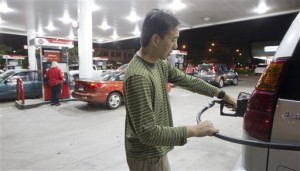Hawaii rattled by tsunami warning after Canada quake

Lyndon Fong of Honolulu fills up his gas tank after learning of a tsunami warning Saturday, Oct. 27, 2012, in Honolulu. Countless Halloween parties were interrupted, restaurants, bars and movie theaters emptied, and highways quickly filled with cars heading away from beach areas. AP PHOTO/EUGENE TANNER
HONOLULU—A powerful 7.7 magnitude earthquake off Canada’s west coast that set off a tsunami warning emptied restaurants, bars and theaters in Hawaii and sent rattled residents fleeing beach areas.
But only relatively small waves rolled to shore on the island of Oahu, and the US Tsunami Warning Center later issued an advisory saying the worst was over.
No damage was reported either in Hawaii or in the Charlotte Islands north of Vancouver where the earthquake struck at 0304 GMT Sunday 86 miles (139 kilometers) south of Masset, the archipelago’s largest town.
“Based on all available data the tsunami threat has decreased and is now at the advisory level and not expected to increase,” the Hawaii-based Pacific Tsunami Warning Center announced.
The center warned, however, that sea level changes and strong currents could still occur and present a hazard for swimmers and boaters.
Article continues after this advertisement“The threat may continue for several hours,” the center cautioned.
Article continues after this advertisementIn Canada, the government’s emergency services agency said, “No areas of coastal British Columbia remain at risk from this event.”
But in the immediate aftermath of the quake, which was followed by strong aftershocks, residents of Hawaii were suddenly spurred into action by a warning that a tsunami generated by the quake was headed their way.
The Pacific Tsunami Warning Center, which initially said there was no “destructive widespread tsunami threat,” later revised the advisory to say a tsunami was headed for Hawaii.
Sirens blared across Hawaii and local officials took to the airwaves, urging residents to head for higher ground – or higher floors if they were in multi-story buildings.
Countless Halloween parties were interrupted, restaurants, bars and movie theaters emptied, and highways quickly filled with cars heading away from beach areas.
Tourists from Waikiki to Turtle Bay in Honolulu were evacuated to higher floors in their hotels, and major tourist centers looked abandoned for several hours.
Governor Neil Abercrombie declared a state of emergency when the first alert was sounded and kept it in force.
“We are taking a wait-and-see approach – we want everyone to be safe,” said the governor’s spokesperson, Donalyn Dela Cruz.
In Canada, residents of the sparsely populated Queen Charlotte Islands appeared to have taken the quake and tsunami warning in stride.
“The tsunami alarm went off and everybody went to the evacuation site,” Danny Escott, owner of the Escott Sportfishing lodge near Masset, told AFP by telephone.
Emergency officials in British Columbia urged residents in low-lying coastal areas to be alert to instructions from local officials and be prepared to move to higher ground.
But officials in Canada sought to calm the population.
“We would not be expecting any widespread damage or inundation,” Kelli Kryzanowski of Emergency Management British Columbia told reporters during a teleconference.
Natural Resources Canada said in a statement that the quake was felt across much of north-central British Columbia, including Haida Gwaii as the Queen Charlotte Islands are also called, Prince Rupert, Quesnel, and Houston.
“There have been no reports of damage at this time,” the agency said.
Gerard Fryer, a senior geophysicist with the Pacific Tsunami Warning Center, said quakes exceeding magnitude 7.0 should not be taken lightly.
“A 7.7 is a big, hefty earthquake. It’s not something you can ignore,” he told CNN International.
He said it had struck partly under an island, but mostly under shallow water.
“I think we have to be thankful it happened where it did,” Fryer said. “If that were a heavily populated area, it would have caused significant damage.”
The Queen Charlotte Islands, also known by their indigenous name of Haida Gwaii, comprise about 150 islands located north of Canada’s Vancouver Island.
Only about 5,000 people live on the islands, about 45 percent of them indigenous Haida people.